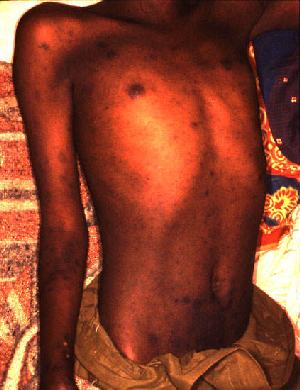Epidemic typhus is a febrile illness caused by the obligate intracellular gram-negative bacterium, Rickettsia prowazekii Rickettsia prowazekii A species of gram-negative, aerobic bacteria that is the etiologic agent of epidemic typhus fever acquired through contact with lice as well as brill's disease. Rickettsia. Epidemic typhus is also known as louse-borne typhus or jail fever Fever Fever is defined as a measured body temperature of at least 38°C (100.4°F). Fever is caused by circulating endogenous and/or exogenous pyrogens that increase levels of prostaglandin E2 in the hypothalamus. Fever is commonly associated with chills, rigors, sweating, and flushing of the skin. Fever, and its symptoms include high fever Fever Fever is defined as a measured body temperature of at least 38°C (100.4°F). Fever is caused by circulating endogenous and/or exogenous pyrogens that increase levels of prostaglandin E2 in the hypothalamus. Fever is commonly associated with chills, rigors, sweating, and flushing of the skin. Fever, headache Headache The symptom of pain in the cranial region. It may be an isolated benign occurrence or manifestation of a wide variety of headache disorders. Brain Abscess, myalgias Myalgias Painful sensation in the muscles. Tick-borne Encephalitis Virus, dry cough Dry Cough Strongyloidiasis, delirium Delirium Delirium is a medical condition characterized by acute disturbances in attention and awareness. Symptoms may fluctuate during the course of a day and involve memory deficits and disorientation. Delirium, stupor, and rash Rash Rocky Mountain Spotted Fever. Untreated epidemic typhus can lead to hypotension Hypotension Hypotension is defined as low blood pressure, specifically < 90/60 mm Hg, and is most commonly a physiologic response. Hypotension may be mild, serious, or life threatening, depending on the cause. Hypotension, shock Shock Shock is a life-threatening condition associated with impaired circulation that results in tissue hypoxia. The different types of shock are based on the underlying cause: distributive (↑ cardiac output (CO), ↓ systemic vascular resistance (SVR)), cardiogenic (↓ CO, ↑ SVR), hypovolemic (↓ CO, ↑ SVR), obstructive (↓ CO), and mixed. Types of Shock, and death. R. prowazekii can be transmitted by the bites of infected mites Mites Any arthropod of the subclass acari except the ticks. They are minute animals related to the spiders, usually having transparent or semitransparent bodies. They may be parasitic on humans and domestic animals, producing various irritations of the skin (mite infestations). Many mite species are important to human and veterinary medicine as both parasite and vector. Mites also infest plants. Scabies, fleas, or lice. Malnutrition Malnutrition Malnutrition is a clinical state caused by an imbalance or deficiency of calories and/or micronutrients and macronutrients. The 2 main manifestations of acute severe malnutrition are marasmus (total caloric insufficiency) and kwashiorkor (protein malnutrition with characteristic edema). Malnutrition in children in resource-limited countries, chronic illness, crowding, and poor hygiene are factors leading to the spread of epidemic typhus. Improvement in nutrition and hygiene can help prevent spread, thereby decreasing the risk of typhus infections Infections Invasion of the host organism by microorganisms or their toxins or by parasites that can cause pathological conditions or diseases. Chronic Granulomatous Disease. The primary method of treatment is using the antibiotic doxycycline.
Last updated: Sep 19, 2022
Epidemic typhus is a potentially lethal, febrile illness caused by the obligate intracellular gram-negative bacterium, Rickettsia prowazekii Rickettsia prowazekii A species of gram-negative, aerobic bacteria that is the etiologic agent of epidemic typhus fever acquired through contact with lice as well as brill’s disease. Rickettsia.
Transmission:
Risk factors:
Geography:

Rash in a patient with epidemic typhus
Image: “Epidemic typhus Burundi” by D. Raoult, V. Roux, J.B. Ndihokubwayo, G. Bise, D. Baudon, G. Martet, and R. Birtles. License: Public DomainAntibiotics:
Prevention:
Prognosis Prognosis A prediction of the probable outcome of a disease based on a individual’s condition and the usual course of the disease as seen in similar situations. Non-Hodgkin Lymphomas: